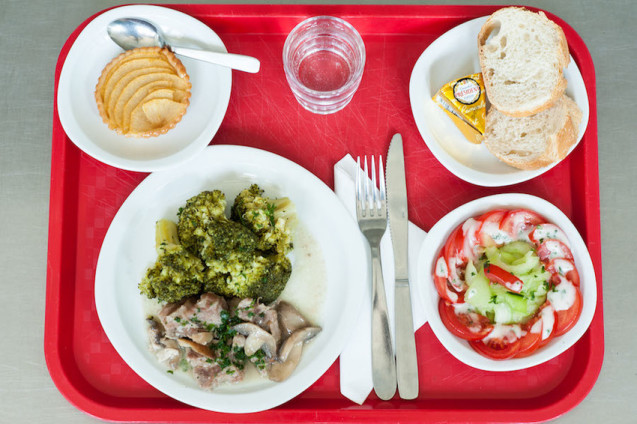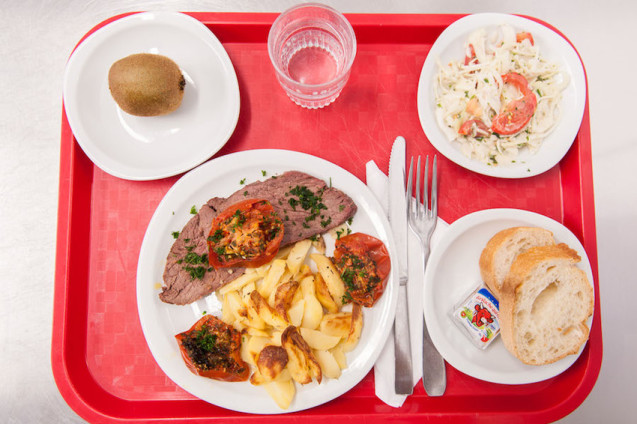Maybe The French Like Children
What French Kids Eat For School Lunch (It Puts Americans To Shame!)
by Rebeca Plantier August 11, 2014 12:42 PM http://res.cloudinary.com/mindbodygreen/image/upload/c_fill,w_994,h_430,g_center,q_80,f_auto,fl_lossy/crp/LittleFashionableFrenchBoyPlayingInLavenderField-825x496.jpg, (default)],[http://res.cloudinary.com/mindbodygreen/image/upload/c_scale,w_770,..., (large)]" />
http://res.cloudinary.com/mindbodygreen/image/upload/c_fill,w_994,h_430,g_center,q_80,f_auto,fl_lossy/crp/LittleFashionableFrenchBoyPlayingInLavenderField-825x496.jpg, (default)],[http://res.cloudinary.com/mindbodygreen/image/upload/c_scale,w_770,..., (large)]" />I walked into the dining room to see tables of four already set — silverware, silver bread basket, off-white ceramic plates, cloth napkins, clear glasses and water pitchers laid out ready for lunch.
I was standing inside my children’s public elementary school cafeteria, or “cantine” as the French call it, in our local town near Annecy, France. As part of my research into why French kids aren’t fat, the local city council gave me a tour of the public school’s cantine and kitchen and let me ask any question that came to mind.
There are many theories as to why the French, and French children in particular, do not suffer from weight problems, obesity, diabetes, and hypertension like their American counterparts. Eating moderate quantities of fresh and freshly prepared food at set times of the day is definitely one of the most convincing reasons why they stay lean. Daily exercise, in the form of three recess periods (two 15-minute and one 60-minute recess every day) and walking or biking to and from school, is another.
So what do French kids eat at school?
Menus are set up two months in advance by the cantine management staff, and then sent to a certified dietitian who makes small “corrections.” The dietitian might take out a small chocolate éclair and replace it with a kiwi for dessert if she thinks there's too much sugar that week. Or she may modify suggested menus by adding more or fewer carbohydrates, vegetables, fruits, or protein to keep the balance right.
Almost all foods are prepared right in the kitchen; they’re not ready-made frozen. This means mashed potatoes, most desserts, salads, soups, and certainly the main dishes are prepared daily. Treats are included — the occasional slice of tarte, a dollop of ice cream, a delicacy from the local pastry shop. Check out these photos of a school lunch being prepared on premises.
Below are photos and a description of one week’s worth of school menus, taken during the last few weeks of this school year in June. French elementary school students don't go to school on Wednesdays, so that's why there are only four meals!
Monday
 http://img.mindbodygreen.com/image/upload/c_scale,w_414,f_auto/ftr/Monday-850x566.jpg,(default)],[http://img.mindbodygreen.com/image/upload/c_limit,w_738,f_auto/ftr/...,(medium)],[http://img.mindbodygreen.com/image/upload/c_limit,w_637,f_auto/ftr/...,(large)]" />
http://img.mindbodygreen.com/image/upload/c_scale,w_414,f_auto/ftr/Monday-850x566.jpg,(default)],[http://img.mindbodygreen.com/image/upload/c_limit,w_738,f_auto/ftr/...,(medium)],[http://img.mindbodygreen.com/image/upload/c_limit,w_637,f_auto/ftr/...,(large)]" />First course: Cucumber and tomato salad
Main course: Veal marinated with mushrooms, broccoli
Cheese
Dessert: Apple tart
Tuesday
 http://img.mindbodygreen.com/image/upload/c_scale,w_414,f_auto/ftr/Tuesday-850x566.jpg,(default)],[http://img.mindbodygreen.com/image/upload/c_limit,w_738,f_auto/ftr/...,(medium)],[http://img.mindbodygreen.com/image/upload/c_limit,w_637,f_auto/ftr/...,(large)]" />
http://img.mindbodygreen.com/image/upload/c_scale,w_414,f_auto/ftr/Tuesday-850x566.jpg,(default)],[http://img.mindbodygreen.com/image/upload/c_limit,w_738,f_auto/ftr/...,(medium)],[http://img.mindbodygreen.com/image/upload/c_limit,w_637,f_auto/ftr/...,(large)]" />First course: Cabbage and tomato salad
Main course: Roast beef, potatoes, baked tomatoes with herbs
Cheese
Dessert: Kiwi
Thursday
 http://img.mindbodygreen.com/image/upload/c_scale,w_414,f_auto/ftr/Thursday-850x566.jpg,(default)],[http://img.mindbodygreen.com/image/upload/c_limit,w_738,f_auto/ftr/...,(medium)],[http://img.mindbodygreen.com/image/upload/c_limit,w_637,f_auto/ftr/...,(large)]" />
http://img.mindbodygreen.com/image/upload/c_scale,w_414,f_auto/ftr/Thursday-850x566.jpg,(default)],[http://img.mindbodygreen.com/image/upload/c_limit,w_738,f_auto/ftr/...,(medium)],[http://img.mindbodygreen.com/image/upload/c_limit,w_637,f_auto/ftr/...,(large)]" />First course: Tabouleh (made with bulgur)
Main course: Sausages, zucchini
Dessert: Ice cream, apple
Friday
 http://img.mindbodygreen.com/image/upload/c_scale,w_414,f_auto/ftr/Friday-850x566.jpg,(default)],[http://img.mindbodygreen.com/image/upload/c_limit,w_738,f_auto/ftr/...,(medium)],[http://img.mindbodygreen.com/image/upload/c_limit,w_637,f_auto/ftr/...,(large)]" />
http://img.mindbodygreen.com/image/upload/c_scale,w_414,f_auto/ftr/Friday-850x566.jpg,(default)],[http://img.mindbodygreen.com/image/upload/c_limit,w_738,f_auto/ftr/...,(medium)],[http://img.mindbodygreen.com/image/upload/c_limit,w_637,f_auto/ftr/...,(large)]" />First course: Potato and pickle salad
Main course: Breaded fish, cauliflower
Cheese
Dessert: Peach
Where does the food come from?
“All our fruits, vegetables, fish and meat are sourced locally, some of them from local farms,” according to Dany Cahuzac, the city counselor in charge of school matters, including the cantine. The local bakery delivers bread, a staple of every French meal, fresh every morning. And every two days, there is at least one organic item on the menu. Once a month, an entirely organic meal is served. The only drink offered at lunchtime is filtered tap water, served in glass pitchers.
Just as important: how the kids eat.
As the children come streaming into the cantine, they sit down at tables of four that are already set and wait for older student volunteers to bring the first course to their table. The child who sits at the designated “red” chair is the only one who is allowed to get up to fetch more water in the pitcher, extra bread for the bread basket, or to ask for extra food for the table. After finishing the first course (often a salad), volunteers bring the main course platter to the table and the children serve themselves. A cheese course follows (often a yogurt or small piece of Camembert, for example), and then dessert (more often than not, fresh fruit).
“We do our best to vary our menus throughout the weeks and months, but sometimes children don’t like certain foods,” explains Cahuzac. “We ask children to at least to taste everything and have a few bites before they give up on a food they don’t like.”
“Eating a balanced meal while sitting down calmly is important in the development of a healthy child,” adds Cahuzac. “It helps them to digest food properly, avoid stomachaches and avoid sapped energy levels in the afternoon.”
What about exercise?
What the French specialize in is moving all the time, not just during a bi-weekly gym class. For example, elementary-aged students throughout the country have three set recess periods during the day: a 15-minute run-around in the morning, a 60-minute recess after lunch, and another 15-minute break in the afternoon. On top of these designated times, children are encouraged to walk and bike to school, although this depends largely on the proximity of home to school. Bicycle parking spaces are usually all used up in the morning at our local school, and while younger students ride to school next to an adult, the older 5th graders often cycle on their own.
Aside from two hourlong periods of gym during the week, kids often walk during school outings and field trips (which can include anything from an hour to the local library, a visit to local farms, to the lakeside for paddleboard lessons, or a hike up a local mountain). Walking is emphasized in even younger ages — indeed 3- and 4-year-olds in preschool will walk up to 2 kilometers in an afternoon to go visit the local library. Sometimes they walk to the local retirement home to sing songs for the elderly.
“Even the youngest children in preschool walk together every week, “ explains Cahuzac. “Those who want to complain usually just follow the pack, and eventually get in the habit of walking.”
Elementary-aged school children in the big French cities walk just as much — it's often easier for them because of sidewalks. Or they use a trottinette (micro-scooter). “My first-grader loves his so much, his father went and bought one for himself,” says Tina Isaac-Goizé. “It gives him another reason to like going to school, plus it is exercise although it takes only half the time of walking.”
Making the French attitude work for us, too.
So what can we do to promote better eating and moving habits for our children stateside?
It all starts at home: We know what healthy foods are, and we need to use our positive influence to feed our kids healthier foods and and teach healthy eating and exercise habits by example.
Home-cooked meals based on plenty of fresh produce, and a weekly family walk, hike or game of tag are simple lifestyle habits that make a difference in a child's life over time.
What about school? Two suggestions: If healthy options are not available in your school, get in the habit of packing a healthy lunch for your child and boycott the cafeteria's fast foods. Then, reach out to local, state and national elected officials and demand better nutrition in your school. To learn how to take specific action for better food at your child's school, visit the official website of Fed Up, a documentary about America's sugar addiction and obesity epidemic.
Lead Photo Credit: Shutterstock.com
Photos of food: Carine Duflos
Comment
-
Comment by DTOM on January 17, 2016 at 6:37pm
-
It's true and it's not just the kids that are slim - what's more detrimental is that most French adults seem to smoke...like chimneys.
Also you have to understand that Lunch is the main meal of the day en France - not the evening meal - the whole country grinds to a halt at midday and only the bars, cafes and restaurants are open for business.
However, in the past 6 years the globalists have been pumping in fast food (KFC / McDonalds / Pizzahut etc marketed heavily on TV) to France, that and crap filler (i.e soya) and artificial junk (Aspartame) have found their way into the food and drink.
There is also a lot more convenience food / ready meals in French supermarkets.
That said, it's much better than say the UK, where soya derived junk filler seems to be in everything.
In the French countryside, folks tend to visit local farm shops and markets on a regular basis for fresh produce, and / or they tend their own produce. There is also lots to harvest in forests -such as mushrooms and boar / deer and seafood on the coast, if you know where to look.
The French have zero time for GMO.
"Destroying the New World Order"
THANK YOU FOR SUPPORTING THE SITE!
Latest Activity
- Top News
- ·
- Everything
What was the Significance of the F-94 C and What role in History?
FLUORIDEGATE: An American Tragedy. a film by Dr. David Kennedy
Rendezvous With The Unknown
Shadows in the Wind
Mossad: we create a pretend world, we are a global production company... the world is our stage
The Alvin II Encounter: Was There A Living Dinosaur Involved?
All In The Family | Mike Meets Archie For The First Time | The Norman Lear Effect
© 2025 Created by truth.
Powered by
![]()

You need to be a member of 12160 Social Network to add comments!
Join 12160 Social Network